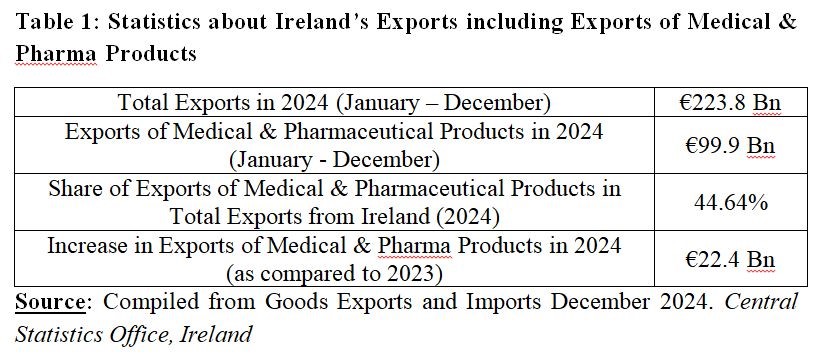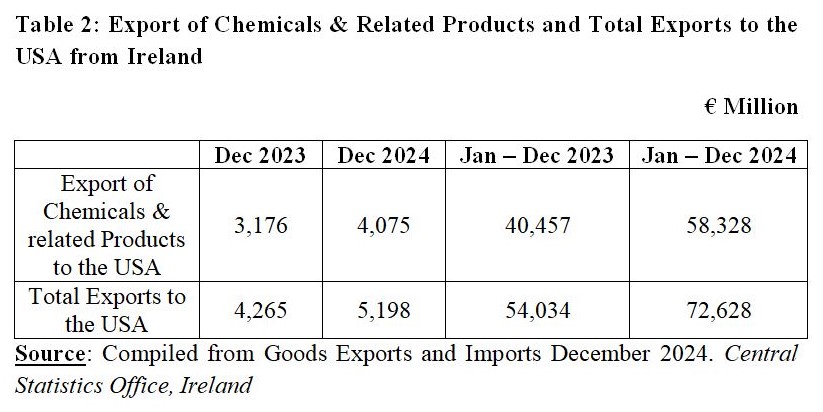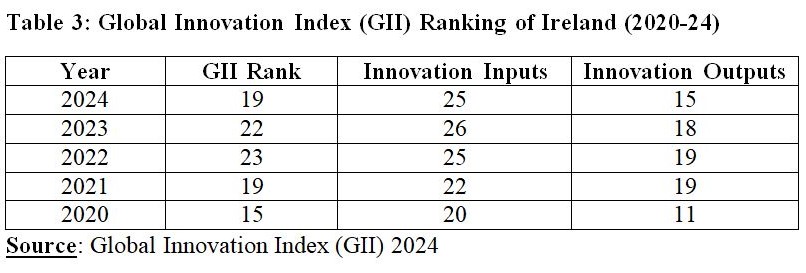On March 12, 2025, the US President met Micheal Martin, Irish Prime Minister, and in his presence, Donald Trump said that ‘Ireland had used its tax policies to lure away pharmaceutical and other companies from the U.S., but U.S. reciprocal tariffs would help rebuild U.S. manufacturing. Trump also blamed U.S. leadership for allowing U.S. pharmaceutical companies and others to move to Ireland.’
Because of quantum of pharmaceutical exports from Ireland, Donald Trump, the U.S. President had to say, ‘All of sudden Ireland has our pharmaceutical companies, this beautiful island of five million people has got the entire US pharmaceutical industry in its grasps.’ This was also relevant in the background that Chemicals & related products formed almost 75 per cent of Total Imports by the USA from Ireland in the Calendar Year (CY) 2023 (January – December). This percentage went up by 5 per cent to touch 80.31 per cent in CY24. Export of Pharmaceuticals from Ireland to the US reached €10.5 bn ($11.8 bn) in February 2025, up from €1.9 bn in February 2024 thereby reflecting 452 per cent growth YoY basis.
Ireland is ranked second in the European Union (EU) in terms of per capita Gross Domestic Product (GDP) of €79,300 which is above EU average of €37,600. Geographical size of the country is 69,947 km2 which is just 0.71 per cent of the geographical size of the U.S. (98,33,520 km2). Even with respect to India, Ireland is just 2.13 per cent of India’s geographical size (32,87,263 km2). Prominent IT companies of the U.S.-origin have set up their European Headquarters in Ireland. The list comprises Apple, Google, Meta, Amazon, X, LinkedIn, Adobe to name a few.
Ireland has become a leading nation in pharmaceutical sector as well. Ireland’s Central Statistics Office (CSO) data shows that overall exports of medical and pharmaceutical products in 2024 stood at €99.9 Bn. In 2024, exports of medical and pharmaceutical products accounted for 44.64% of all Irish goods exports, and exports of pharma products rose by 29.0%. In contrast to this, India exported pharmaceutical products worth $30.38 Bn in FY25 out of which exports to the USA alone stood at $10.51 Bn (34.61 per cent of the total pharma exports). In 2023, Ireland was 4th largest exporter of pharma products after Germany, Switzerland, and the U.S. whereas India was 11th largest exporter of pharma products.


It is interesting to observe the growth of pharmaceutical industry in Ireland. Ireland has become an attractive destination for pharma companies to set up their base. 10 of the world’s largest pharmaceutical companies are based in Ireland. Prominent pharmaceutical companies which have their operations in Ireland include Johnson & Johnson (J&J), Eli Lilly, Pfizer, Merck, Takeda, Sanofi, Novartis, Bristol Myers Squibb, Regeneron, Gilead, janssen, AbbVie, MSD, GE Healthcare, Baxter, Zoetis, among others. Pharmaceutical Companies consider skilled workforce, regulatory environment, and pro-innovation government policies as major factors behind their presence in Ireland.
Johnson & Johnson is operating in Ireland since 1935. J&J employs more than 6,000 persons from Ireland. J&J operations span ten sites across Ireland, and operations include R&D, manufacturing, shared services, and commercial operations.
Pfizer opened its first site in Ireland in 1969. Since then, the company had invested $8 bn in operations. The company has six sites in Ireland, and carry out functions such as R&D, manufacturing, shared services, treasury and commercial operations thereby employing around 3,700 employees.
Merck Group has been active in Ireland since 1977. Merck Group is represented in Ireland by Merck Serono (Ireland) Ltd., Merck Millipore Ltd., Ireland and Merck Life Science UK Limited.
MSD has significant presence in Ireland. MSD Ireland established its first site – MSD Ballydine in Ireland in 1976. Now, the company has six sites in Ireland. These sites cater to biologics-based medicines, global and national support services (Clinical Research, Medical Affairs, Regulatory Affairs, Sales, Policy & Communications and Marketing) among others. In January 2025, MSD acquired a vaccine plant from WuXi Biologics for €500 million (or $521 million). WuXi Biologics had announced in 2019 about its investment of €200 million to build this vaccine plant. The Company has invested $3.5 billion in Irish operations and the company’s annual turnover ranks as one of the Ireland’s top 20 companies.
Eli Lilly established operations in Ireland in 1978. Eli Lilly is manufacturing Zepbound, its weight-loss drug at the manufacturing facility in County Cork. Eli Lilly also has a Global Business Solutions center in Cork that employs more than 2,000 employees by 2024-end. More than 50% of these employees work in clinical research and development. Eli Lilly announced the Limerick site in 2022, that became operational in March 2023. On September 12, 2024, Eli Lilly announced a $1 bn expansion of its Limerick, Ireland, manufacturing site for increasing production of biologic active ingredients. With this investment, total investment of Eli Lilly in Limerick stood at $2 bn. To ensure safe, reliable supply of medicines, and right-first-time execution, the company deployed advanced technologies such as Machine Learning (ML), AI and automated robotics and systems on this site. Production of biologic active ingredients for Lilly medicines will start in 2026. Besides this, the company also unveiled its new $800 mn facility expansion in Kinsale, Ireland which started manufacturing medicine sin 2023 to meet demand for the company’s latest diabetes and obesity treatments. Kinsale site has employed a digital-first process which integrates continuous manufacturing technology. In Kinsale, the company has the ‘single largest privately owned solar farm’ of 26 acres. Eli Lilly employs more than 3,700 employees across three sites and remote roles.
Multiple factors have encouraged pharmaceutical companies to set up their base in Ireland. These attractions include Low Corporation Tax, higher per capita GDP, availability of skilled workforce due to presence of all major pharmaceutical companies in the country, ranking in the Global Innovation Index (GII), to name a few. Low Corporation tax of 12.5 per cent is the key attraction for companies to set up their operations in Ireland. The decision to introduce the rate of 12.5 per cent was originally announced in 1997 and became effective in 2003. This rate is still applicable for businesses with revenue less than €750 million. In October 2021, the country signed up to the OECD Pillar Agreement which included the agreement of a global minimum effective rate of 15 per cent.
In Global Innovation Index (GII) 2024, Ireland ranked 19th among 133 economies and ranked 11th among the 39 economies in Europe. Among the 51 high-income group economies, the country is ranked 18th.

To conclude, the USA is ranked as the largest economy in the world whereas Ireland is ranked 33rd economy in the world. But the increasing presence of the pharmaceutical companies of the U.S.-origin in Ireland and import of chemicals & related products from Ireland by the USA forming more than 80 per cent share of total imports by the USA from Ireland in CY24, has raised the concerns for the USA.
Dr. Anil Kumar Angrish– Associate Professor (Finance and Accounting), Department of Pharmaceutical Management, NIPER S.A.S. Nagar (Mohali), Punjab
Disclaimer: Views are personal and do not represent the views of the Institute.





